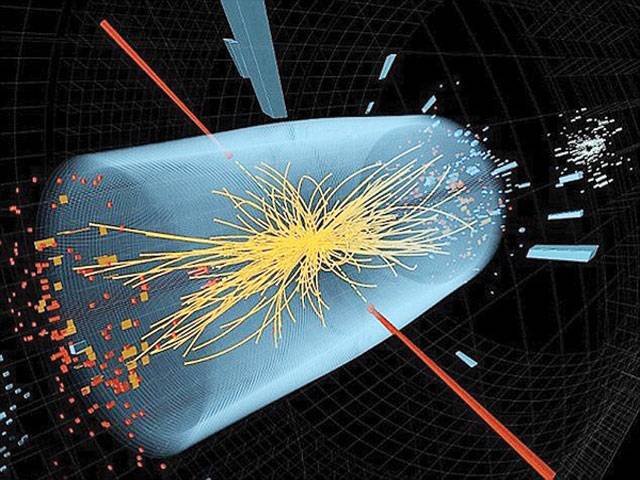Geneva - The first sign of a particle heavier than the Higgs boson was seen at the Large Hadron Collider (LHC) back in December.
Unexplained by current models, its existence might lead to the discovery of a whole new set of particles and possibly even a fifth fundamental force. But the first results were not enough to confirm the particle exists, and now a second run of tests have failed to find this mysterious particle, MailOnline has learned.
In data produced last December at the LHC in Geneva, two separate measurements found what looked like a particle six time heavier than the Higgs boson.
'We should have enough data by mid-July to either confirm the result or place serious doubt on its existence,' Professor James Olsen, CMS physics coordinator and a physicist at Princeton, told MailOnline in June.
Scientists have now gathered the evidence ahead of the International Conference on High Energy Physics (ICHEP) that will begin next week in Chicago.
A theoretical physicist working at CERN in Geneva told MailOnline the official results will be revealed at the end of next week. But the source said the signal has not been confirmed by experiments starting from April this year.
Two of the detectors, ATLAS and CMS, were searching for new physics by counting particle decays that ended up in two photons.
Measuring photons is a good method for detecting new physics because photons are easy to detect and physicists know what to expect in terms of results from background events.
They both separately saw photons with a combined energy of 750 GeV. When particles decay into photons, they release energy equivalent to their mass multiplied by the speed of light squared.
‘We're all familiar with Einstein's most famous equation, and this observation is it in action. This means the particle that produced these photons is an as yet unknown with this exact amount of energy in the form of its mass.
'It weighs about 750 GeV, corresponding to about six times heavier than the Higgs boson, and almost 800 times heavier than the proton,' said Ellis. But some scientists were skeptical all along.
'I don't see any statistically significant bump/signal/particle in last year's data,' Patrick Janot from the CERN physics department told MailOnline. 'When you do 1000+ analyses, it would be totally unnatural - and actually suspicious - not to see one with a 3 sigma excess.
'The new data might confirm, or not, my impression. Either way, it'll be announced at CERN shortly before the ICHEP conference.'
This new particle, if it existed, was not predicted by the Standard Model, so would open up physicists to a whole new unexplored world and could lead to the discovery of a new set of particles.
Finding a particle like this would be exciting because the Standard Model has left some questions unanswered for years, so scientists are keen to break free of it and find new theories.
It can't explain gravity, for example, because it is incompatible with our best explanation of how gravity works - general relativity, nor does it explain dark matter particles.
A separate study published today offered a different explanation to these 750GeV signals.
'This was a very surprising announcement and a puzzle at the same time, because the lifetime and mass of the particle could reveal something else beyond simply one extra particle, if it turns out to be a real signal,' said Professor Kyoungchul Kong, associate professor of physics and astronomy at the University of Kansas. 'Yet we do not claim this as a discovery, and we need more data.'
The group suggested instead of a single particle decaying to produce the 750GeV signal, the researchers suggest there is a series of different particles.
'Every explanation of the 750 GeV excess needs a new particle. Most models assume one around 750 GeV.'
Rather than basing his theory on the existence of a 'resonance' particle with a straightforwardly corresponding mass to trigger the 750 GeV signal, Professor Kong's paper proposes a sequence of particlesat different masses, without one at 750 GeV.
Other researchers at CERN told MailOnline the idea could be proven or dispelled with further tests.
'This theory is rather speculative, and personally I would not pay it much attention,' one physicist said. 'To the extent that it does not predict a narrow peak, it could be tested.'
Professor Janot told MailOnline 'their explanation is as interesting as many others,' but added further tests could tell whether the theory is correct.
'We explore ideas,' Professor Kong said. describing theoretical particle physicists. 'Probably most of ideas are wrong-but we learn from them, and we propose better ideas.'
Daily Mail






